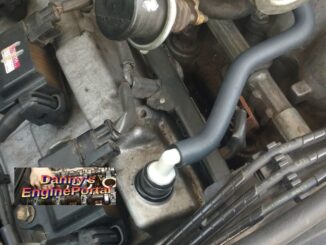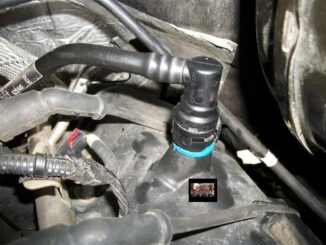Did you know the most common problem, in the (PCV) system, is a plugged up (PCV) valve.
Another problem, is a lack of air flow, to carry vapors, away from the crankcase.
Because, without air flow, moisture contamination remains and a sludge buildup, is often a result. Furthermore, operating the engine without adequate ventilation, is a leading cause of engine sludge.
So, the (PCV) system can be blocked, from an accumulation of fuel and oil varnish deposits and/or sludge.
Consequently, a restricted or clogged (PCV) system, cannot pull moisture and blow-by vapors, out of the crankcase. As a result, this can cause, engine damaging sludge to form.
And, may even cause a backup of pressure, that may force oil to leak past gaskets and seals. The loss of airflow through the (PCV) system, can also cause the air fuel mixture, to run richer than normal. But, the same thing can happen, if the pintle inside the valve, sticks shut.
If the pintle inside the (PCV) valve, sticks open or the spring breaks, the (PCV) valve may flow too much air and lean out the idle mixture. Consequently, causing a rough idle, hard starting and/or lean misfire, (which increases emissions and wastes fuel).
Loose Or Leaky Hoses
This can also happen if, the hose to the throttle body, carburetor or intake manifold, pulls loose, cracks, or leaks.
A loose or leaky hose, allows “un-metered” air to enter the engine and upsets the fuel mixture. Especially at idle, where the idle mixture is most sensitive to vacuum leaks.
Incorrect (PCV) Valves
Problems can also occur if, someone uses, the wrong (PCV) valve for the application. The flow rate of the (PCV) valve, is calibrated for a specific engine application. So, two valves that appear to be identical on the outside, may have different pintle valves and springs inside. Consequently, giving them very different flow rates.
A (PCV) valve that flows too much air, will lean the air fuel mixture. However, one that flows too little, will richen the mixture and increase, the risk of sludge buildup in the crankcase.
Basic (PCV) Airflow Testing
Pinch or block off the vacuum hose to the (PCV) valve, with the engine idling at operating temperature. The engine idle (rpm), should typically drop about 50 to 80 (rpm), before the idle speed corrects itself. But, if there is no change in idle speed, check the (PCV) hose and breather tube, for a restriction. A greater change, would indicate too much airflow through the (PCV) valve. Because, the wrong valve may flow, too much air.
Checking For Leaks
Measure the amount of vacuum, in the crankcase. With the engine at normal operating temperature, block off the (PCV) breather tube or vent to the engine. Pull out the dipstick and connect a vacuum pressure gauge, to the dipstick tube. Consequently, a typical (PCV) system should be pulling, about 1 to 3 inches of vacuum in the crankcase, at idle.
So, if you see a significantly higher vacuum reading, the intake manifold gasket, is probably leaking. Consequently, pulling vacuum from the crankcase. If you see no vacuum, or find a buildup of pressure in the crankcase, the (PCV) system is plugged. And, is not pulling enough air through the crankcase, to get rid of the blow-by vapors.
If the engine has a leaky oil pan, valve cover, intake manifold gasket, or crankshaft seals, it will not be able to develop much vacuum in the crankcase. Because, it is pulling in outside air (which is also unfiltered and can further contaminate the oil).
To find a crankcase air leak, you can lightly pressurize the crankcase, with shop air. (no more than 1 to 3 psi). You can do this, via the dipstick tube, oil filler cap or breather, after blocking all the other vents. But, do not use any more pressure than this or you may create leaks, where there were no leaks before.
Then use a spray bottle, to squirt soapy water, around the gasket seams and seals. Consequently, if you see bubbles, you have found an air leak (replace the gasket or seal as needed and retest).
Conclusion
So, keep in mind that some new models, don’t have a valve at all. Instead, you’ll find a simple vacuum hose going from the valve cover, to an air inlet duct. Others may have a simple, restrictor in place. Still, you can check the restrictor, hoses and other parts.
BY DANNY BENDER




